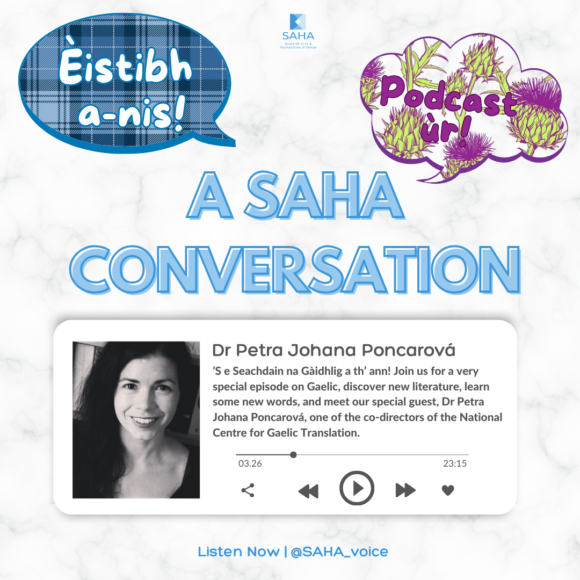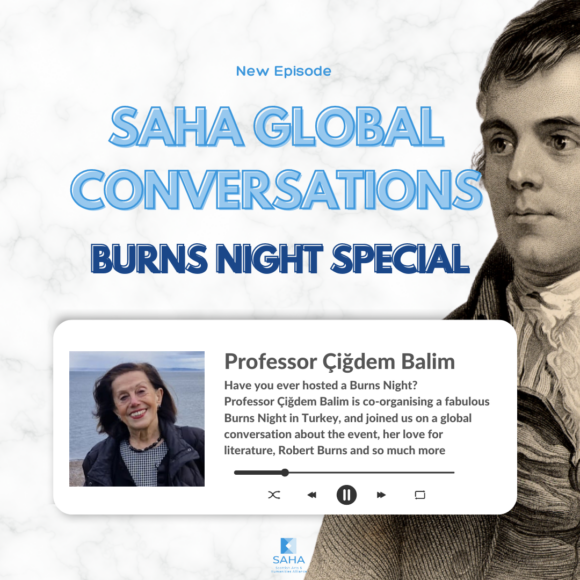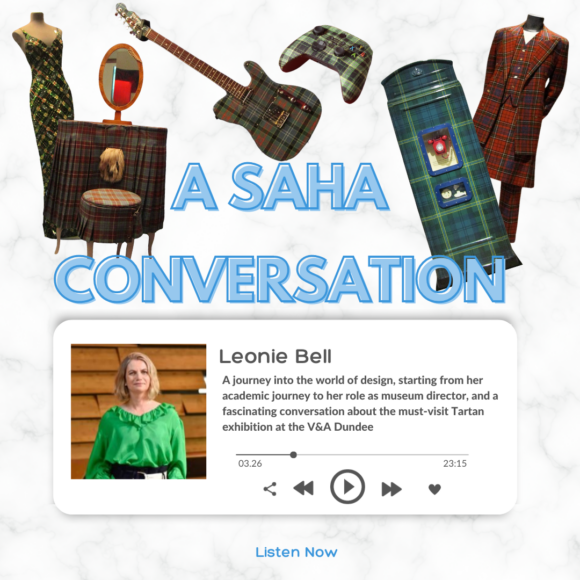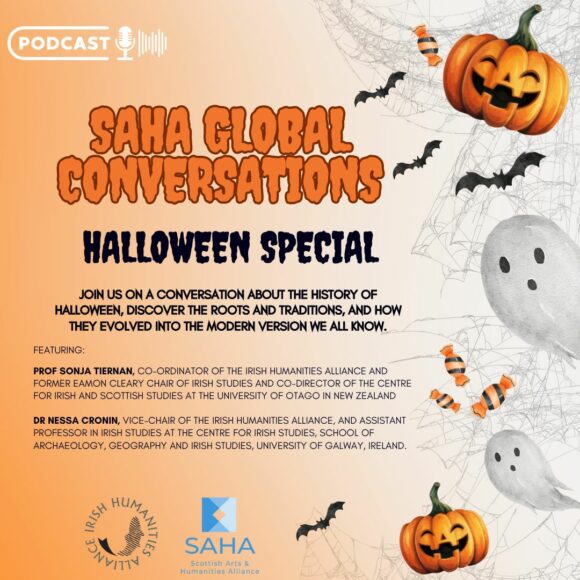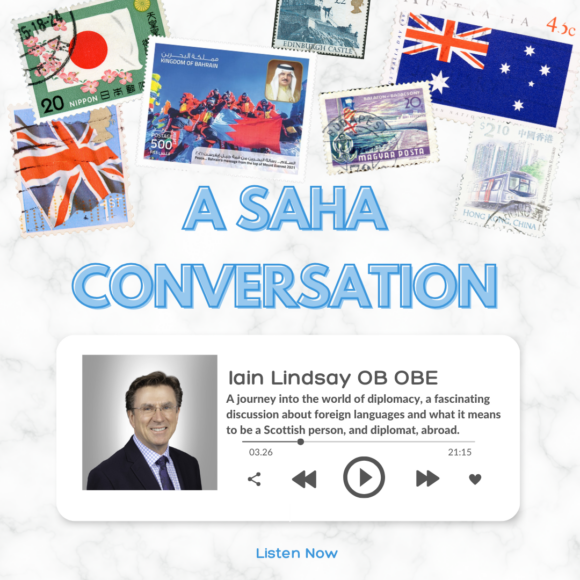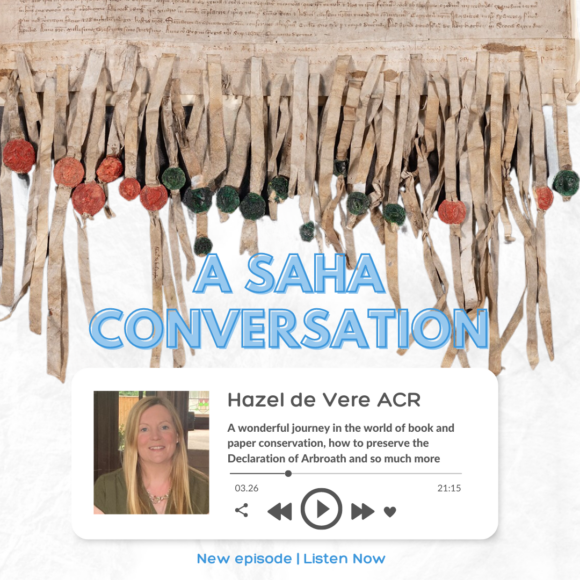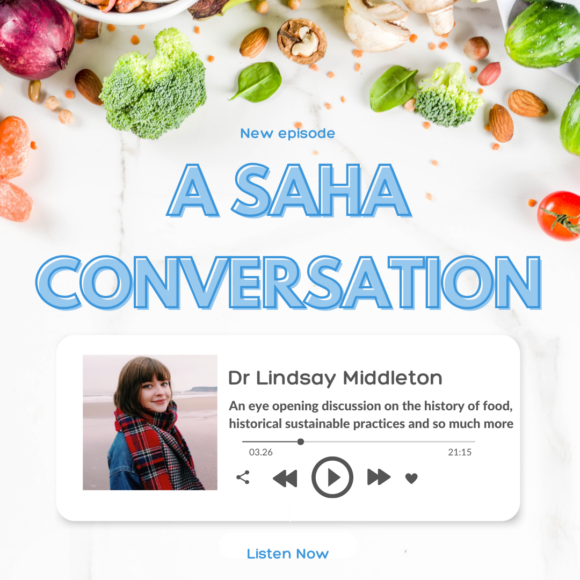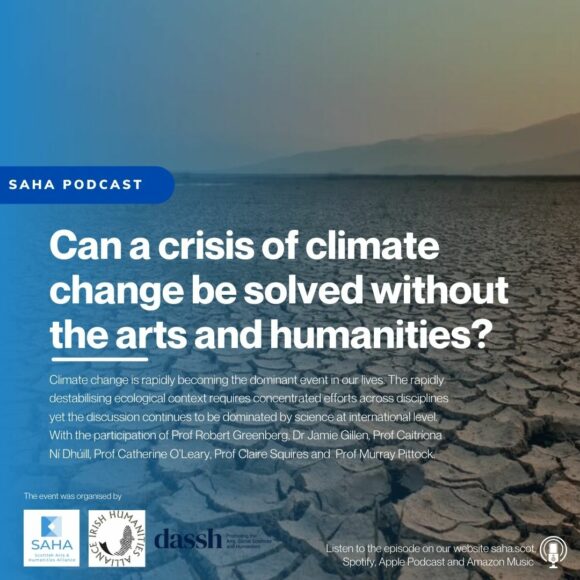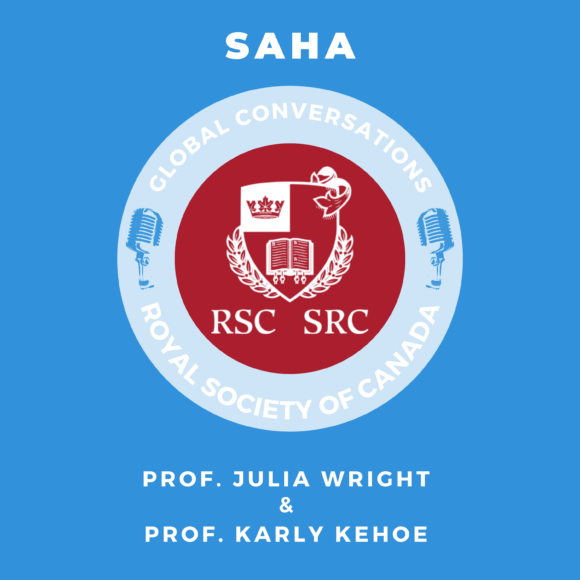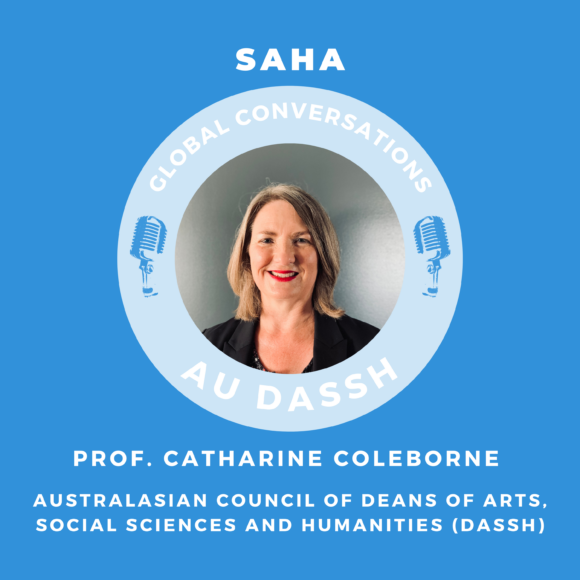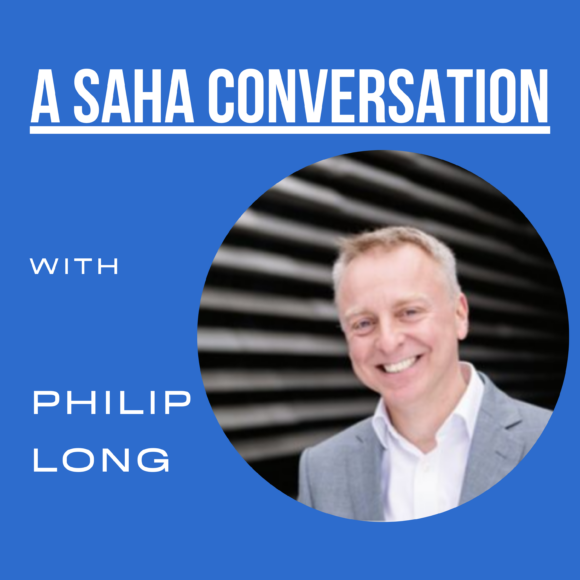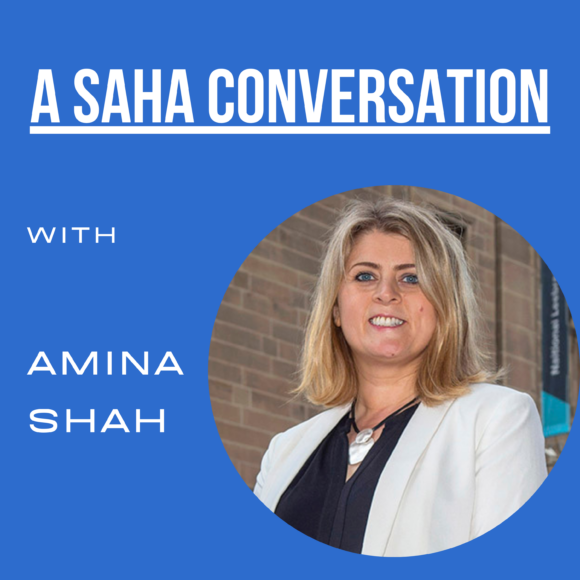We are delighted to bring you a new SAHA Conversation. Our guest this week is Jane McCulloch. Jane McCulloch is the Consul General of Ireland in Edinburgh, having taken up her post in July 2019. Jane is a career diplomat who has served Ireland at home and abroad for fifteen years. Jane has served abroad as Deputy Head of Mission and Consul at the Embassies of Ireland in Warsaw and Copenhagen, and at home in various roles across the Department of Foreign Affairs, including as Head of Integrity in the Passport Service, in the Humanitarian Unit of Irish Aid, and on State Visits in DFA’s Protocol Division. Before joining the Department of Foreign Affairs, Jane worked in the events industry, delivering major outdoor public events. She graduated from the University of St Andrews in 2002.
Our SAHA Conversation includes Jane’s reflections on her career and on the contribution of arts & humanities to international relations. As this conversation was recorded in the first week of February 2022, and St Patrick’s day on March 17th was just around the corner, we also discussed St Patrick’s Day and what it means for Ireland and the Irish diaspora.
Resources mentioned:
- Consulate General of Ireland in Edinburgh
- Ireland-Scotland Bilateral Review
- Boyne to Brodgar project
- The Book of Kells
- Colmcille – An Naomh Dána (TG4 and BBC Alba documentary)
- Athbheatha: Colm Cille Ildánach (A celebration of the 1500th anniversary of Colmcille’s life through works of art – TG4 documentary)
- An Irish – Scottish celebration of St Brigid’s Day 2021
- The 2022 St Brigid’s Day event Women’s Voices in Arts & Media (organised by the Consulates General of Ireland in Cardiff, Edinburgh, and Manchester)
- Causeway Ireland – Scotland Business Exchange Young Professionals Network
 Transcript
Transcript
[01:37] Cristina: Good morning and thank you for joining our SAHA Conversation today, Jane, we’re delighted to have you as a guest for our podcast.
[01:45] Jane: Well, Cristina, thank you very much for inviting me to be part of the SAHA podcast. It really is my pleasure to speak with you and to join your listeners today.
[01:54] Cristina: We usually begin this podcast series by asking our guests to reflect on their career trajectory and how this has related to their university studies. So that would be my first question for you then, what are your key reflections on that?
[02:10] Jane: Well, Cristina, this September it will have been 25 years since the spires of St Andrews emerged around that last bend in the road from Guardbridge, as I came up to the university for the first time. I knew of St Andrews as a golf town my whole life. My grandfather was fanatical about the rules of the game, and he pored over the updated rulings when they arrived every year. But it was really only in my last year of school that I became aware of the university. It was suggested to me by my headmaster, and in the end I decided I’d rather travel across to Fife to study English than to stay at home. And I think there’s a clue in there as to why I ended up becoming a diplomat. My plan then as an 18-year-old, as much as 18-year-old plans ever work out, was to become a journalist. And I had benefited from the advice of a seasoned correspondent to consider taking a degree in the arts and humanities rather than jumping straight into a degree in journalism. Journalism and communications degree courses were becoming increasingly popular back then in the 1990s. And that was what I had thought I should do. But rightly, in my case at least, I was advised to take a broader approach, to learn more, and not to pigeonhole myself. And while I was at St Andrews I was involved in The Saint Newspaper, and I had a few pieces accepted in both Irish and Scottish dailies during my student years. So I thought that was the way I was going to go. But ultimately, for myriad reasons, only some of which I think I remember, I graduated and wanted to get involved in event management, which I did, in Scotland and later on in Bristol. And during those years, I had also begun the application process for the Irish Department of Foreign Affairs. And it was in 2007, ten and a half years after I think I’d left to study in Scotland, I came back to Dublin and joined the Department of Foreign Affairs as a diplomat. Since then, I’ve served at home and abroad with roles in Protocol, Irish Aid, the overseas development side of the Department of Foreign Affairs and in our Passport Service. And I’ve also served abroad as deputy head of mission in both Denmark and Poland. And in 2019 I came full circle and I came back to Edinburgh, as Ireland’s Consul General here. I think when I was at St Andrews, the key reflection really would be how I benefited from the Scottish degree structure. I entered into English and Classics and finished graduating with English Literature and Language. And along the way I studied across the three Faculties of Arts, Science and Divinity, though principally in the schools of the Faculty of Arts. And I’m not sure I remember every subject, and I did have to repeat one or two I have to say, but obviously it was English and Classics; I also studied in Schools of Medieval History, Art History and Economics among others. And my sojourn to the Faculty of Science involved coding and early web publishing. So, one way or another every subject that I studied or maybe didn’t study as well as I should have, has had relevance to my work. But most importantly, the skills and ways of thinking and ways of viewing the world around us, is what I would take away as my greatest benefits from my studies, to my career since.
[05:25] Cristina: Thank you. Actually, the point that you made about the breadth of study across different departments and different degrees is something that was mentioned by several of the podcast guests also. And we’re going to discuss about your work more specifically a bit further down the line, but for now I wanted to ask you a little bit more about St. Patrick and why St. Patrick’s Day stands out for you and for Ireland.
[06:05] Jane: St. Patrick, of course, was Welsh, some claim he was Scottish, but he’s considered to be Welsh and he was brought … the story is that he was brought as an enslaved shepherd to Ireland. And I actually live at home in the village of Slane in County Meath, where he lit his Paschal fire, where he came back to Ireland to introduce Christianity to the country. And the high kings in Ireland communicated on their feast days with fires lit on hills. And he went up the hill of Slane and lit a fire, and was challenged as to why he had lit this fire when he had no permission to do so. I’m greatly simplifying the story here, Cristina, for brevity. And in the end, he converted the high king, who he was challenging, to Christianity. And so, Christianity arrived in Ireland. He used the shamrock, the three-leafed small plant to explain the Christian Trinity. And that’s why the shamrock is associated with St. Patrick’s Day, with Ireland. And of course, for those who celebrate Christian holidays, St. Patrick’s Day remains important in the church. But that’s not the reason that it is our national day. Ireland has a separation of church and state so it is a civil holiday that we celebrate as our National Day. And the considerable thing to me and this is a personal reflection now, I’m not sure all of my colleagues fully agree with me as to bringing St. Patrick’s Day down to two factors. But for me there’s two, and one is that wherever you are in the world, Irish people are there. We are a nation of emigrants. And emigration forms the backbone of our identity, with a diaspora of 70 million people worldwide. And with only 5 million people living on, or just over that, on the island of Ireland, that’s a colossal number of people who consider themselves Irish by citizenship, or Irish by descent, or Irish by association. So in that sense, St. Patrick’s Day globally is very much a diaspora celebration. And then secondly, as a national holiday, it isn’t a commemoration of a sombre event, or indeed, in some countries cases of a tragic event. That’s often the case where national holidays quite rightly mark the formation, or the re-establishment of a state. But that’s not the case of St. Patrick’s Day. So because it’s not a sombre occasion, I suppose we have a lot of artistic license in how we celebrate it and how we mark the day, both within our communities and formally as diplomatic representations overseas.
[08:42] Cristina: Oh, that’s very interesting to learn. So, just to move our conversation towards international relations and your work, I wanted to ask you first, though, what role do you think arts and humanities have or could have in international relations more generally?
[09:03] Jane: Well, I think cultural diplomacy is an obvious answer here, Cristina. We all as Foreign Services promote and protect our countries’ interests around the world. And that can sound … and in some cases and sometimes, that is a very technical process and it can be quite fraught, depending on the countries of representation, or the countries in which we are working. But one thing that all countries do that is generally very positive and welcome and accessible, because naturally not all of diplomacy is seen in the public eye, is cultural diplomacy. And it’s all very, you know, we can think of the Edinburgh festivals for example, which provide one of the greatest international stages for the presentation of culture to audiences from around the world and the Edinburgh festivals are hugely important to Ireland. They provide the largest stage off the island for the presentation of culture and the arts from Ireland. So they’re hugely important to us and form a large part of our work at the consulate for example. But it goes, you know, it’s much more subtle and much broader than that as well. If we don’t share our culture and if we don’t engage with and appreciate the culture of others, we’ll never understand each other as people. Ireland is incredibly lucky, we have a fantastic canon of, in particular my interest of literature, that is renowned and hugely read the world over. But every country has a canon of literature worth reading. And we learn so much more about peoples and about ways of living and about our differences by engaging at a personal level with each other’s culture, but also presentationally as nations. They’re a welcome soft diplomacy, soft, the soft power, that you often hear spoken of, is closely associated with our cultural diplomacy. And, you know, I say that for all countries. I think the other thing is, going back to what I reflected on the way in the arts and humanities education, how we learn to think. And whereas the way of analyzing things, information, situations, absorbing large amounts of information, often very complex, and reproducing it, is critical to international relations and diplomacy, the other thing is that diplomacy is never a zero-sum game. If it were a zero-sum game, there would be no diplomacy. So that creativity, that reflection … I often refer to thinking around corners. That is, I think, a strong legacy from the arts and humanities into the world of diplomacy, and how we conduct ourselves while serving our countries. I mean, I have to say, in the Department of Foreign Affairs in Ireland we don’t have prescribed subjects that are required to join any more than we do … some countries require a degree in law, for example, and there’s obvious merit and read across there. In Ireland we don’t; we have scientists, we have lawyers, we’ve those from the arts and humanities, and all different fields. And that’s important too because one thing that is never wasted in diplomacy is another perspective.
[12:27] Cristina: I love the metaphor of thinking around corners, it’s very expressive. Just to stay on the topic of Arts and Humanities and I guess our role at SAHA is to signpost or even to promote work that is going on in Arts and Humanities. And although you maybe wouldn’t be so familiar with the work that we do, in the sense that it’s a lot of academic work, I was wondering if you might be able to think of some projects, arts and humanities projects, that you’ve seen in your career that could be highlighted?
[13:05] Jane: I think, obviously, speaking with SAHA today, that the key reflection would be looking at Ireland and Scotland. And I think when I was working on the joint bilateral review, the Ireland-Scotland joint bilateral review, in which we examined what it is that we do well between Ireland and Scotland and what we can therefore do more of to mutual benefit. One of the projects that I discovered, and it actually forms a case study in that document, is the Boyne to Brodgar initiative. And that is obviously, the Boyne is where I’m from again, in county Meath where, there we have a World Heritage Site of Neolithic tombs and all the wider hinterland of that is closely linked with Brodgar, so the Neolithic monuments in Orkney, which I have to say I’ve had the great pleasure of visiting. Before we got into lockdowns, Orkney was as far as I got in Scotland, and had a lovely trip up there and had the pleasure of visiting many of these monuments myself and understanding more of this project, but the Boyne to Brodgar initiative, it’s a network of museums, of universities, independent experts, but also involves local authorities, community groups and so on, looking at everything associated with the Neolithic heritage to celebrate it, to further those bilateral links and to create legacies. And I mean, one of the particular challenges that I know huge amounts of work has been done in Orkney from which we’re learning, is around the erosion of some of these sites, both in terms of the sea and climate change, but also in terms of increased visitor numbers. So, you know, that involves everything from the more scientific elements of climate change to the archaeological study and understanding and preservation, to working with local authorities, with tourist agencies and so on, and the communities in which these monuments are sited. So that to me is a really wonderful example of a shared heritage from a shared time; and these are World Heritage Sites in Ireland and Scotland, that are so much more than their history or their tourism value, that cohesive approach to protect them and promote them and to share … most importantly, to share that knowledge and share that understanding to mutual benefit. And the Boyne to Brodgar initiative isn’t a … it doesn’t have a time stamp on it, it doesn’t have a very tight structure, you know, it’s one of those wonderful initiatives that when it’s needed, it keeps going.
[15:45] Cristina: That’s a wonderful example and you’ve actually led me to my next question in a very neat way because that was going to ask more about the Scottish Irish bilateral review. So would you mind telling our listeners a little bit more about this project and also what you’ve learned from working on this for a few years now?
[16:10] Jane: So work began on this joint bilateral review in 2019 as I took up my post here in Edinburgh. I’m not the initiator of it, I might say, the timing was not of my making. But I was delighted to be able to begin my posting here working on this with partners in Scottish Government and well beyond Scottish Government. And two significant things about the review just to put it in context. It does form a wider part of Ireland’s deepening and strengthening of relationship in Britain. You may be aware, we reopened … shortly before that we had reopened our Consulate General in Cardiff, and just last summer we opened a new Consulate General in Manchester. And there’s a similar, but very different exercise has been undertaken in Wales. But the interesting… one of the other interesting elements of this review, which we undertook looking at Scotland, was that it was the first time we’d ever undertaken a joint bilateral review. It’s very common for foreign ministries to do a review of their bilateral relations with another country, a region, or an area in which they operate. We did this jointly with the Scottish Government. So obviously, it was absolutely constrained to the areas that are devolved to the Scottish Government. That’s a very, very clear boundary in the approach that we took and continue to take and in the document itself. So it looks at where we work together as governments, and all of that is within the structure of the British-Irish Council which followed on from the Good Friday Agreement where the governments of these islands, so the two sovereign governments, the three devolved governments and the Crown Dependencies meet together and work together in the structures of the British-Irish Council. So there’s that. Then the five main themes are culture, business and economy, academic and research, diaspora and community, and rural, coastal and islands. So all of these are very much interlinked. And for me what was quite interesting was the final recommendation that we added, the 41st recommendation of the work that we will do together to strengthen relationships to the benefit of people in Scotland and in Ireland over five years. The final one is that everything we do has to be seen through a rural, coastal and island lens, that it’s the overriding theme; when you consider the geography and the human geography of our two countries, that we we have to stop everything we do and say: How does this … are we actually paying attention to the broader countries that we represent, to avoid looking in the Scottish context, I suppose, through the Central Belt lens? which is very easy to do in some government initiatives. And also in … from an Irish perspective, are we going out to the cities? Are we going into the small towns? Are we looking at regions? So that’s really, to me, that’s the most important recommendation in the entire review, is that it reminds us of the physical and human geography of Scotland and Ireland, which are extremely similar in many ways, but have myriad subtle and important differences too.
[19:18] Cristina: Thank you. It’s really interesting to hear from a person that was closely involved in the process.
[19:26] Jane: Just to go back to the process, I should have said more on that. I mean, one of the elements of the process, it was curtailed and truncated by us having to go into lockdown, so what we envisaged doing as part of the consultation process and going further about and maybe some of the people or organizations that we might have liked to get around tables, we simply had to restrict the process because of COVID 19. But that is not to say that that’s to the exclusion of some of those partners in the delivery of the recommendations, and it will evolve to some extent each year as our ministers review it and tell us whether they think we’ve done a good job and whether there are more elements they would like us to involve. So it is a live process – is the first thing. And the second thing is, we did a joint consultation exercise online. So, that allowed … it was qualitative and quantitative, we had particular questions we wanted answers to, and to understand whether things were viewed from an Irish in Scotland or a Scottish in Ireland, or a different perspective altogether, how they viewed how we operated as governments, how they viewed how our links worked at a community level, cultural level and so on. Some of that was well measured, but it was also… it allowed for a lot of open responses. So we learned a huge amount through that process. There were more than 1000 responses to that exercise, which, when we had considered what we expected to get back, it really was multiples in terms of participation. But the real, real value in it, was how much people gave in their responses, whether as organizations or as individuals. And we learned of all sorts of projects, we learned all sorts of collaborations and connections across all of life between Scotland and Ireland, which we might not otherwise have known about. And that’s not to say that we weren’t looking for it. But Scotland and Ireland are so close, as all of Britain and Ireland are in so many ways. And there’s such organic collaboration going on that most of it there’s no business having a government sticking our two feet into the middle of it. We simply want to be aware and to help promote and celebrate that. And that’s the real strength of this. That as the Government of Ireland and the Scottish Government as the kind of guardians and custodians of this process, that’s not to say we’re the guardians or custodians of the entire relationship, we have our role, and the process of this review is to guide and enhance and really be a catalyst in what is happening because it’s worthwhile anyway, we’re not trying to reinvent any wheels.
[22:02] Cristina: It’s important as we’re looking towards the future to think about the past also, and you’ve mentioned the links between Scotland and Ireland. And I was wondering also, if you could reflect a little bit more about this shared history, the shared past, and also maybe some of the historic figures that link the two countries?
[22:23] Jane: Well, I think, if we were to talk of the shared history between Scotland and Ireland we might need not just one podcast or one series of podcasts, but we might need a couple of years’ worth of them. So I won’t attempt to capture the breadth of historical connections or the depth of them in my answer, but I think there’s one figure of recent and immediate significance who I think is worth reflecting on, and that’s Colmcille or Columba. And last year, the 1500th anniversary of his birth was celebrated. And he is often known or understood as an ecclesiastical figure. He came from Ireland to Iona, of course, from where we believe the Book of Kells went back to Ireland for safekeeping. And the Book of Kells will be well known to anyone who considers the Long Room of Trinity College, the fabulous library and this treasure, which is guarded there. But Colmcille was an awful lot more than an ecclesiastical figure. He was, you know, considerable in the introduction of Christianity to Scotland. But he was also a warrior, he was a diplomat. I know some Scots have said to me, when he banished the cattle from Iona, he also banished the women, so we’re not sure how much we like him in 2022. And I think all these criticisms are fair. He was a complex character. And he … there was a recent joint production, a kind of drama-documentary on TG4 and BBC Alba, An Naomh Dána, which means the bold saint. And it’s well worth looking out if it’s on the BBC iPlayer for listeners in the UK, or on the TG4 programme, that’s the Irish language television station. Their programmes are available globally. It is subtitled to be fair to those who don’t speak Gaelic or Irish. It’s quite a wry look at the history of the saint, but it does capture his life and the various threads of it. But he’s also very significant in legal terms, he invented the concept of intellectual property. So Colmcille is this kind of foundational link between Ireland and Scotland. That’s an oversimplification as we referred to the Boyne to Brodgar, the links are thousands of years older, but given the layers of life, from the ecclesiastical, through the arts, through legal and so on, in which he was involved and then the continuing community links, I think he’s probably the most significant figure that we can point to as shared in our common history. And just to say, in addition to that television programme that I would recommend having a look at, there’s also on the TG4 player, a short documentary, looking at some contemporary work, which was commissioned by the Royal Irish Academy with the Department of Foreign Affairs to reflect on his legacy and in a contemporary expression and in a current climate what that meant to some of those artists. So that’s visual arts, musical and literary. And those pieces, some of them can be viewed online at the moment, but we’re looking forward to celebrating them and sharing them in the coming months. And they were commissioned from Scottish and Irish artists. And for some of them we’re looking forward to … to performance and so on in the coming months. So the main thing there is taking these historical figures and not living in the past with them, but bringing them into a contemporary context, and understanding that legacy through that prism.
[25:56] Cristina: That’s very interesting, thank you, and there are some great recommendations there and I think the listeners can follow these links in the show notes.
[26:08] Jane: And I should clarify when I casually refer to TG4, for those who don’t speak Irish, that’s TG4, the number four, that’s the Irish language television station. And there, there’s some wonderful material on that, generally, it’s a fantastic television company. And they produce some fabulous work, all of which is subtitled for those who can’t access it. And there’s some real treasures in there well worth exploring.
[26:32] Cristina: And just to move from the past to look towards the present, we’ve already mentioned COVID and as we’re recording this, we haven’t put this behind us yet, but hopefully we will soon. But we were wondering what influence do you think COVID has had on international relations?
[26:54] Jane: Considerable, would be the short answer. Diplomacy, by its nature, is about people and it’s about connecting. And it has been hugely disrupted in terms of those people-to-people contacts. Certainly, my reflection would be that at a conservative estimate, I should spend 60% as a minimum of my time beyond the front door of the Consulate in Edinburgh, out in other parts of Scotland, meeting other people. And obviously, I spent close to 100% of my time behind my own front door at home, which really has disrupted what we can do in Scotland. I’m sure there are people, maybe listening to this podcast, who would have expected to have met me in person by now. And that hasn’t happened. And in the time I’ll still be in Scotland, I will be increasing my travels around the country to meet more people and have those conversations and make those connections. But in general, diplomacy is about people-to-people connections, and it’s about conversations and understanding. And everything that we do is down to the power of communication. And while the one positive has been… and we’re speaking through Zoom today, Cristina, Zoom and all these other platforms have allowed for a certain amount of continuity in a lot of these relationships. It isn’t the same. And we really, really felt that collectively as diplomats around the world when it began and as we emerge, in fits and starts over the last couple of years, through the easing of restrictions and hopefully now into a more … greater return to human contact, we really feel the difference when we’re back together with people. So I think that’s very, very important. And I would just say as well, that the key about communication there, the most important thing in communication is to listen, not to speak. And that is a very, very different process when it’s done in the room with people than when it’s over a screen in two dimensions. So I think, I think more listening is going to happen as we can come back face to face again. And I think that’s only a really, really good thing. I would I suppose, try and take another positive out of this, of what’s happened. I mentioned cultural diplomacy earlier. And normally, I would be welcoming people into the Consulate, and again meeting them face to face and hosting cultural events and celebrating Irish authors and shared collaborations between Scottish and Irish artists and so on. Just to give you a very quick example, having rediscovered … we’ve talked about St. Patrick and St. Colmcille. And our third Irish saint, of course, is St Brigid, who was a very fierce and famous pagan goddess before she became a Christian saint. And in the last number of years in the Department of Foreign Affairs we reintroduced the celebration of Brigid’s Day and very much focused on the creativity of women, which is what she stood for. So in 2020, in Glasgow Women’s Library, we hosted a fantastic event to introduce this celebration of Brigid to Scotland. And of course, we haven’t managed to do that since. Last year we had a fantastic online, we had wonderful videos of Irish and Scottish female poets performing their work. We did that as a collaboration with our friends in Scotland. Which meant we could at least continue, and this year as a … well it just wasn’t clear to us that by the first of February, that we could host our guests in person again. So, collectively with my colleagues in Cardiff and Manchester, we recorded an event and broadcasted online last week on the first of February. It was a fantastic event, I hope you’ll put the link in as well, speaking to women in arts and the media. But within the first week of recording it, the number of people who had watched it, was a multiple of the number of people that we could have hosted in Edinburgh, in Cardiff, and in Manchester, at in-person events. So there is a positive in many regards as to the people we can reach with some of our work, but there’s of course, other work that we do where we really, really need to be in person.
[31:06] Cristina: I’m so glad you mentioned Brigid, I find her very fascinating.
[31:13] Jane: We love Brigid to the point that we believe Brigid is now a verb, not just a name and a noun. So to Brigid is to really be powerful and creative, particularly as a woman and to take that … that care and creativity and bring good in the world.
[31:09] Cristina: Now this is I think a very important message, especially for our listeners who identify as women. And to kind of finish our conversation today, I usually ask our guests to offer some advice. And this is advice of a personal nature, of course. Given what you’ve seen so far in your career, what advice would you give students who are considering choosing arts and humanities degrees today, but also to those who are graduating and who are now looking to their next step, starting or kind of changing their careers as a result of their degrees?
[32:21] Jane: I would always suggest keeping a broad view. Don’t pigeonhole yourself. Either because you’ve studied something and feel that dictates a career path, or because you’ve already had a career and feel you can’t do something different if you want to. I’ve essentially, to a greater or lesser extent, had three careers. And even within my longest one, as a diplomat, there’s been huge variety. But every day I draw on those areas that I worked in before, I draw on what I studied. But most importantly, through all of those, I draw on what I have learned. And don’t define what you have learned by letters on a piece of very important parchment, that shows what you’ve earned in terms of a degree, or a later professional qualification, or an employment contract. We all learn so much more than can be defined by those things. And the broader we keep our view, the more we learn, and the more we, therefore, bring to what we’re going to do next. I’d say, the straight line is not necessarily a direct line to where we want to go. And there is an awful lot … a bit like walking down a country road, you’re going to see an awful lot more as you meander through the countryside than if you get on high-speed transport and head down a motorway that might get you there two hours more quickly. It certainly won’t be as rewarding a journey if you keep your line straight. So I would say, meander, keep your view broad, and be kind to yourself, if you feel you’ve made a mistake or a wrong decision. It might feel like that at the time, but you’ll look back on what you learned from it, and it will help you define where it is you wish to go, or what it is you wish to do. And going back to the point I made earlier about communication, listen. And always, always ask others for advice. Choose carefully who you ask for advice. But most of us no matter how busy we are in our professional lives, are delighted to share our mistakes and reflections, possibly in too long-winded away like I do, with those who would like the advice. And I have to say through the career service in St Andrews and the Causeway Ireland – Scotland Business Exchange Young Professionals Network, I’m always delighted when I’m asked to give some feedback or advice or be a sounding board for people who are making these decisions and wondering where to go next. I’m very glad I didn’t take a straight line going where I thought I wanted to go.
[35:16] Cristina: Thank you, Jane, I really enjoyed the conversation today and learned a lot, I must say, from the short discussion that we had. Thank you so much.
[35:24] Jane: Thank you, Cristina, I’ve really enjoyed our chat.
